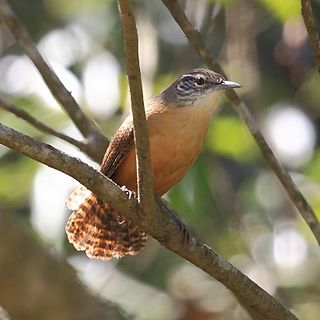
The marsh wren is a small North American songbird of the wren family. It is sometimes called the long-billed marsh wren to distinguish it from the sedge wren, also known as the short-billed marsh wren.

The sedge wren is a small and secretive passerine bird in the family Troglodytidae. It is widely distributed in North America. It is often found in wet grasslands and meadows where it nests in the tall grasses and sedges and feeds on insects. The sedge wren was formerly considered as conspecific with the non-migratory grass wren of central and South America.

The ochraceous wren is a small songbird of the wren family. It is a resident breeding species in Costa Rica, Panama, and Colombia.

The sepia-brown wren or Sharpe's wren is a species of bird in the family Troglodytidae. It is found in Colombia, Ecuador, and Peru.

The Peruvian wren is a species of bird in the family Troglodytidae. It is endemic Peru.

Apolinar's wren is a passerine bird in the family Troglodytidae. It is endemic to Colombia.

Cistothorus is a genus of small passerine birds in the family Troglodytidae.

The Mérida wren, or paramo wren, is a species of bird in the family Troglodytidae. It is endemic to Venezuela.

The song wren is a species of bird in the family Troglodytidae. It is found in Colombia, Costa Rica, Ecuador, Honduras, Nicaragua, and Panama.

The chestnut-breasted wren is a species of bird in the family Troglodytidae. It is found in Colombia, Ecuador, Peru and Bolivia.

The grey-breasted wood wren is a species of bird in the family Troglodytidae. It is found from Mexico to Bolivia.

The timberline wren is a species of bird in the family Troglodytidae. It is found in Costa Rica and western Panama.

The buff-breasted wren is a species of bird in the family Troglodytidae. It is found in the Amazon Basin of northern Brazil and Amazonian Colombia, Ecuador, Peru and northern-border Bolivia, and also the Guianan countries of Guyana, Suriname, and French Guiana. It occurs in non-Amazonian regions of Venezuela and Colombia and its range extends into eastern Panama.

The spot-breasted wren is a species of bird in the family Troglodytidae. It is found in Belize, Costa Rica, El Salvador, Guatemala, Honduras, Mexico, and Nicaragua.

Cabanis's wren is a species of bird in the family Troglodytidae. It is found in Belize, Costa Rica, El Salvador, Guatemala, Honduras, Mexico, and Nicaragua.

The speckle-breasted wren is a species of bird in the family Troglodytidae. It is found in Colombia, Ecuador, and Peru.

The sooty-headed wren is a species of bird in the family Troglodytidae. It is found in Colombia and Panama.

The superciliated wren is a species of bird in the family Troglodytidae. It is found in Ecuador and Peru.

The white-bellied wren is a species of bird in the family Troglodytidae. It is found in Belize, Guatemala, Honduras, and Mexico.

The isthmian wren is a species of bird in the family Troglodytidae. It is found in Costa Rica and Panama.
























